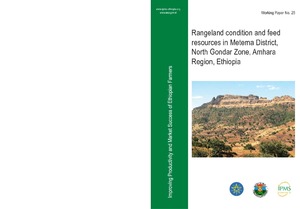Resource information
The study was conducted in 2006/07 in Metema district, North Gondar Zone of Amhara
region, Ethiopia, with the objectives to characterize the existing rangeland and to
determine the feed resources utilization practices, to assess the natural grazing land
condition based on herbaceous, woody and soil condition and to evaluate the chemical
composition of major livestock feed resources of the area. A single-visit formal survey, group discussions and visual observations are used to collect the primary information and secondary sources are also used in livestock feed resources assessment of the district. A total of 140 respondents from 7 kebeles were selected for interviewing by stratified random sampling techniques. To assess the range conditions, the samples were collected by classifying the district into cotton–livestock and sesame–livestock farming systems. Within a farming system, grazing lands were further stratified into three sampling areas: communal, road side and enclosure grazing areas. In each of the range sites a sampling block of 4 km × 1 km was demarcated and this was further stratified into four sampling plots of equal size. In each of the plot, a belt transects of 50 m × 4 m
was laid out randomly. Then, the parameter used for (herbaceous, soil and woody) grass
species composition, basal cover, litter cover, soil erosion, soil compaction, seedling count, age distribution and woody density enumeration, canopy cover and hedging
were determined. For the height classes <0–1 m, >1–3 m, >3–4.5 m and >4.5 m was
used. Feed samples were stratified by season and types and subjected to chemical
analysis for determination of DM, ash, CP, ADF, ADL and IVDMD. About 83% of the
inhabitants in the district practice mixed crop–livestock farming system. The mean family size is 5.31 ± 0.20 persons per household, while the average land holding is 6.78 ± 1.33 ha/household. The mean livestock holding per household is 12.52 ± 6.23 TLU,
and is composed of cattle, goats, sheep, donkeys and camels. Natural pasture (55.7%),
crop residues (20.7%), stubble (14.3%) and hay (9.3%) are the major feed resources
for dry season whereas in the wet season only natural pasture serves as feed resource.
The total estimated DM yield of grazing land and stubble is 780,750 and 51,954 t DM
per annum, respectively. The total estimated available feed supply is 833,531.2 t DM
per annum. Of the identified 33 herbaceous species, 14 and 19 are different grasses
and non-grass species. From the non-grass species 6 legumes and 13 sedges and other
species are recorded. Of the grasses, 23.07%, 38.46% and 30.77% are highly desirable, desirable and less desirable, respectively. Of the identified 20 woody species, 15%, 35%, and 50% are highly desirable, desirable and less desirable, respectively. The largest proportion of woody vegetation is contributed by different species of acacia (20%)and commbretum (10%). Trees and shrubs grouped within the height class of >1–3 m constituted 41.2% in communal grazing areas, 38.5% in road side grazing and 33.3% in enclosures. Range condition assessment factors such as basal cover, litter cover, grass species composition, woody vegetation density, canopy cover, hedging effect, age
distribution and total condition score are significant (P<0.05) in communal grazing areas of the sesame–livestock than in the cotton–livestock farming system. The communal
grazing areas have significantly (P< 0.05) higher values of grass species composition,
basal cover, litter cover, age distribution, and woody species density score, than the road side grazing areas and lower (P<0.05) than the enclosure grazing areas. The dry matter biomass of grass, highly desirable, desirable species of grasses and legumes and others obtained in the same farming system were significantly (P<0.05) higher than the road side grazing types and lower (P<0.05) in total grass biomass, highly desirable grass, and total biomass than enclosure areas. The total dry matter biomass, dry matter biomass of grass and highly desirable grasses, and legumes are significantly (P<0.05) higher in the enclosure followed by communal grazing and the road side grazing areas. In general, there is low feed resources conservation and utilization and very poor traditional grazing land management system in Metema. The abundant feed resources in the wet season are wasted. In the dry season, grasses are turned to ash by wild and man-made fire in the process of forest honey harvesting and crop land cleaning. As a result, the livestock
populations seriously suffer from the critical feed shortage during the long dry season.The rangeland, species composition and biomass production are also affected by human, livestock and natural factors (biotic and abiotic factors). The human population of the district has increased due to settlement programs, investment induced settlers, expanding crop cultivation and have increased the pressure on the rangelands and natural grazing
areas. Bush encroachment and overgrazing are also serious problems. Shifting cultivation
practice is also contributing to the increased bush encroachment. The seasonal
movement and transhumant livestock production by highlanders in adjacent districts also increases the grazing intensity. Absence of adequate baseline information about the rangeland resources, unsynchronized seasonal availability of feed resources and cropland encroachment to the rangeland are some of the main constraints of the district, and studies on rangeland management systems and improved livestock production should be initiated.


